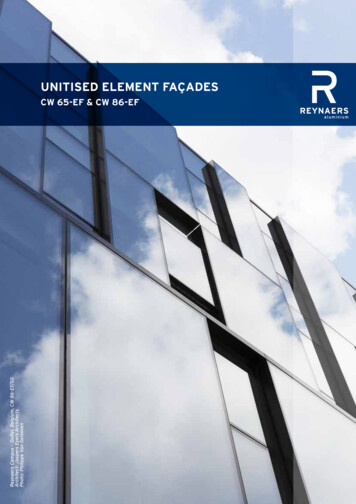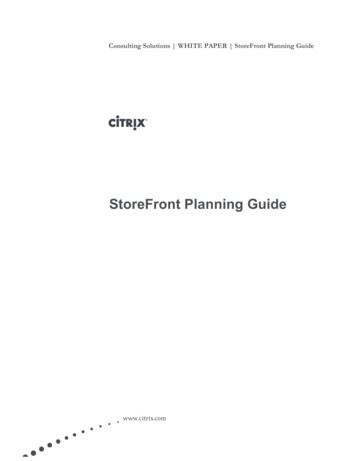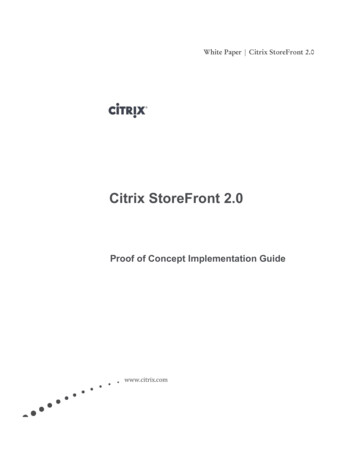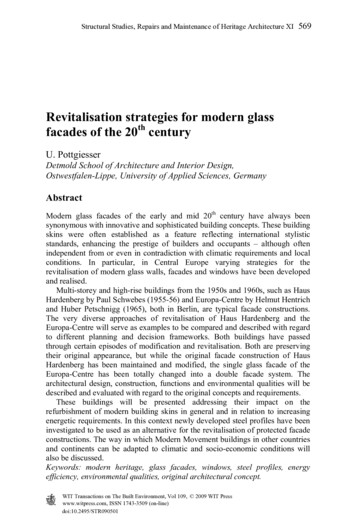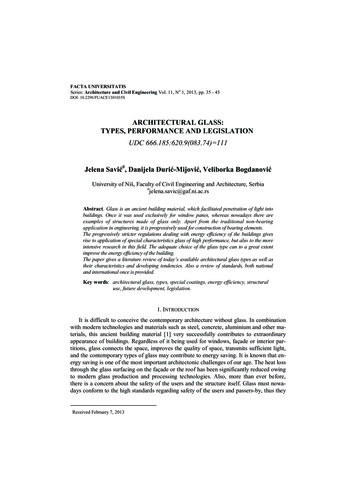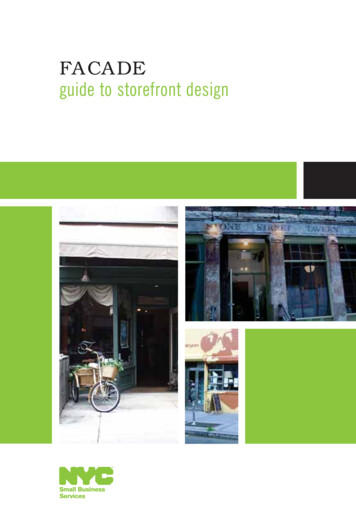
Transcription
FACADEguide to storefront design
Michael R. BloombergMayorRobert LieberDeputy Mayor for Economic DevelopmentRobert W. WalshCommissioner, Department of Small Business Services
New York City’s diverse collection of commercial districts is in large part defined by thecharacter and quality of their individual storefronts. When executed well, the storefrontcan serve as an invitation to the shopper, increasing business for individual merchantsand improving the overall shopping experience. Well-designed storefronts can create anenvironment where people will want to linger, shop and return again.The New York City Department of Small Business Services has developed this Guide toStorefront Design to help you understand the individual elements of the storefront – thesign, awning, lighting, color and security devices – and make good design decisions. Wehave also provided you with an overview of some of the regulations relating to storefronts,and direction on compliance.At SBS we are committed to assisting New York City’s small businesses and commercialdistricts. To learn more about how the City of New York can help your business, visit us atwww.nyc.gov/sbs. We hope this manual can be a useful tool as you consider improvementsto your storefront.Sincerely,Robert W. WalshCommissioner
TABLE OF CONTENTSStorefront Design . 1Steps to Storefront Renewal . 2Signage . 3Awnings . 6Lighting . 8Color . 9Security . 10Gateboxes . 11Graffiti . 12Before & After . 14Top Ten Storefront Design Tips . 16Historic Preservation . 18Special Purpose Districts . 20Rules & Regulations . 21Signage Code . 22Department of Buildings . 24FAQs . 25Storefront Improvement Programs . 26Glossary . 27
storefront designThe general guiding principal of excellent storefront design is to keep it simple, and to letthe natural architectural elements of your building and storefront speak clearly. Let’s firstlook at some of the different components of the storefront so you know where you canmake improvements. Not all buildings have all of the architectural elements below, butthese storefront components should translate to most building types.CORNICEImportant decorative andunifying element of thefacade. Preserve, anddo not cover with signage.WINDOWSPreserve existingdetailing. Do not fill orblock original windowopenings. Upper storywindow signage isnot attractive anddetracts from characterof the facade.LIGHTINGSIGNAGESee page 8See page 3AWNINGSee page 6TRANSOM SASHIf at all possible, do not fill thisspace with air conditioning unit.It can dip and make the entranceto your store unsightly.DISPLAY WINDOWLet your merchandise speakfor itself by leaving thewindow clear of signs.Small window decals areattractive and inexpensive.BULKHEADSKeep these as close to theiroriginal design and materialsas possible. Covering themdestroys the proportionsof your facade.SECURITY GATESSee page 11STOREFRONT DESIGN 1
steps to storefront renewalCHECKLISTINVENTORY YOUR EXISTING ASSETSLook at what you have – older buildings often have interesting architectural details that may have beencovered up over the years. An interesting and attractive facade can be an asset and enhance your sales.Check to see if you are in a landmark building or historic district. If you are, there are additional rulesthat pertain to making changes in that building (see page 18).GENERATE IDEASThink about what changes you could make to improve the street appearance of your store. Rememberthat too much visual clutter can confuse your customer. If possible, let the merchandise speak for itself.Brainstorm ideas – hopefully this guide will help inspire some ideas. Look around at other establishmentsthat have particularly nice facades. Contact any local resources such as a local development corporation,chamber of commerce or business improvement district for technical or financial assistance for your project.UNDERSTAND REGULATIONSFind out which zoning regulations govern your building. For instance, each area may have different rulesand regulations when it comes to sign requirements. More details on zoning are included on page 21 of thisbook. To find your zoning district you can log onto the NYC Department of City Planning at nyc.gov/planningor call the Zoning Information Desk at (212) 720-3291.Make sure you know what permits are required for the work you want to do. Most of the time you will needto engage the services of a licensed architect, engineer or signhanger to submit the paperwork to theDepartment of Buildings.HIRE QUALIFIED VENDORSLicensed architects can be found by contacting the local chapter of the American Institute of Architects.Information can be found at www.aia.org. To search for license status for any professionals (contractors,engineers, etc.) you can go to www.op.nysed.gov. Signhangers are licensed through the Department ofBuildings and an updated list can be found at html. Inaddition, the Department of Small Business Services maintains a database of minority and women-ownedbusinesses that could meet your contracting needs, visit www.nyc.gov/sbs to access this list.2 STEPS TO STOREFRONT RENEWAL
signageSigns are one of the most cost-effective and eye-catching ways to draw more attention toyour business. Effective signs are attentive to the scale of the building and the point of viewof the pedestrian. Though it may surprise you, the simpler the sign, the more attention itwill likely get. Studies have shown that people quickly reach a visual saturation point – ifthere is too much visual clutter, people shut down and ignore all of the signs around them.A bigger sign is not always better.Below are some examples of different types of signs used in New York City today that willwork for both the merchant and shopper to give you an idea of all the different ways youcan announce your store name.Painted Plywood Sign: This is a greatexample of an eye catching solutionthat is simple yet creative.Painted Glass: Painting your namedirectly on the glass is a very low-costand attractive option.Fabric Sign: A low-cost choice, yet itrequires more frequent replacementand upkeep.Punched Metal Signboard: Durableand eye-catching.Metal Logo and Lettering: Thisthree-dimensional sign which castsa shadow creates another levelof texture.Metal Signband: By using just twocolors and minimal text, the eye isimmediately drawn to the sign.SIGNAGE 3
In addition to the applicable district regulations in C1 and C2 districts (see page 21 for zonedesignations), the total square footage of all signs should not be greater than three timesthe street frontage of the ground floor establishment or more than 150 square feet. Forexample, a ten foot wide store could erect a sign no larger than 30 square feet. Also in C1and C2 districts, the signage may not be higher than 25 feet above curb level. In C1 and C2overlays in residential districts, signage may not extend into the residential portion of amixed-use building. In C4 districts signage may extend as high as 40 feet and may havea total square footage equal to 5 times the street frontage of the ground floorestablishment, but not more than 500 square feet.Metal Letters affixed directly to the building:Excellent choice for minimizing how much of the buildingitself gets covered up.Wooden Letters on Signboard:Fitting your sign into the signband area defined by thearchitecture is important to maintain the integrity ofthe building and project an upscale image.Illuminated Sign: Generally internally lit signs are notdesirable, but this one fits well into the scale and contextof the building.Metallic paint on wooden letters glass background:These letters stand out against the material and fit intothe architecture of the window.4 SIGNAGE
Signs from earlier in the 20th century: if properly maintained, older signs can be rich and beautiful elements of acommercial district.Shingle signs: Small shingle signs are an attractive, eye-catching way to display your business name. Make sure they complywith specific zoning regulations.Signs that do not require a permit: Non-illuminated signs that are six (6) square feet in total area or less, or those that arepainted on exterior walls do not need a permit, but they must comply with local zoning regulations.SIGNAGE 5
awningsAwnings define storefronts and embellish the commercial street. They are attached to andsupported solely by the building.Zoning regulations require that lettering on awnings be no higher than 12 inches and notcover more than 12 square feet of space; only the name and address of the business arepermitted to be printed on the awning.Awnings were originally invented as a shade and sheltering device – to protect merchandisein the window from the sun and to cover the pedestrian from the elements. In the bestcases, they still serve these functional purposes.The retractable awningson the side of this restaurantare a great choice because theylast much longer and can bekept clean easily. Plus, evenwhen retracted, as above, theystill draw attention.These awnings are properlyfitted into window openingsof the building. Larger awningsthat cover up the facade arestrongly discouraged, asthey detract from theoverall streetscape.6 AWNINGS
A very simple awning that announcesthe business can be very effective andcosts less than a retractable awning.These awnings fit into thearchitectural elements of thebuilding and are visually effectiveby restricting text to just thename of the business.This retractable awning isideal. It can be kept clean andwell-maintained while providingshade from the sun.GOODBADNot only are corporate logos illegal,but they also mean that customerswon’t notice the name of yourbusiness – which can severelyhamper your ability to beremembered.Awnings must be maintained. Thisripped and shredded awning sends amessage that the business does notcare about its products.This awning is illegal. It includesmore information than just thebusiness name and address.AWNINGS 7
lightingWarm, inviting lighting can entice people down the street to your business. Lighting isalso a proven crime deterrent. The selective use of illumination elements like neon canbe especially eye-catching as well. All exterior lighting should be done by a licensedelectrician. Illuminated signs may not be permitted in some zoning areas.NEONThe selective use of neon can be quite effective in drawing the customer’s attention.8 LIGHTING
colorAn astute use of color differentiates your business from the rest of the street and is one ofthe most cost-effective ways to dramatically improve the appearance of the facade. Alwayskeep the architectural features of the facade in mind when picking colors.SINGLECOLORIn both of the examples above, a fresh coat of a simple white paint applied to all of the storefront elements presents a unifiedappearance that makes each store stand out.TWOCOLORSDISTINCTIVECOLORThe same effect was achieved by using one color of green (above right), while a edgier approach, yet still unified, was usedabove, left. Still, despite the eye-catching design, note that only two colors of paint were used. Generally three is the maximumnumber of colors one should use.COLOR 9
securityPhysical security elements are important to any storefront business. Ideally, “invisible”electronic security systems should be used. But if you must use a gate, an open-gridsecurity gate creates a “24-hour” business by allowing potential customers to view windowdisplays after hours. Open link security gates also provide greater visual access forsecurity and will not be blemished by graffiti which brings down the entire neighborhood.Note how graffiti has already appeared on the solid partof the security gate, whereas the open grid part makes graffitiimpossible.The solid security gate closes off the streetscape and makesthe area seem less safe. Also, for stores, pedestrians thatpass by when you are closed cannot see what merchandiseyou are selling.Open grid gates allow merchandise to be always on displayand makes the entire street more appealing and graffiti-free.Open grid security gates offer protection in two ways – theynot only shield the window but allow for visibility into thestore from both pedestrians and police patrolling the area.Case in point: Madison Avenue merchants (example above)display very expensive merchandise, but feel that open gridgates provide the security they need.10 SECURITY
gateboxesGate boxes (the long boxes above a store window that hold the rolled-up security gate whenit is not in use) can be very unsightly additions to a store facade. Attention should be paid tohow these boxes fit into the front of your store. They can be mounted behind a store window,inside the store itself, or concealed behind an awning or a sign. (Where signage is mountedon a gatebox, the signage and gatebox cannot project more than 12 inches over the sidewalk.)At the very least, the box can be painted to fit in with the building or signage colors.Here the boxes are painted. One ispartly concealed behind signage.Boxes hidden beneath awnings.Another example of a well-concealedgate box behind an awning.AWNINGSIGNGATEBOXGATEBOXGATEBOXES 11
graffitiGraffiti sends the message to your customers that the area is not safe, or that thebusinesses do not care about welcoming people to their stores. Graffiti that remains onbuildings invites further vandalism. The Mayor’s Anti-Graffiti Task Force was establishedin 1995 as a vital part of the City’s effort to improve the quality of life for all New Yorkers.The Mayor’s Anti-Graffiti Paint Program distributes graffiti removal supplies to civicgroups planning clean up projects (www.nyc.gov/cau). If you are not involved with a civicgroup and have property that has been vandalized by graffiti, you can request the City toremove the graffiti. To make a request, send in a properly filled out waiver form with aletter from the building owner requesting the City to remove the graffiti. The Anti-GraffitiProgram Paint Waiver Form can be downloaded at www.nyc.gov/cau. The form may bereturned by mail to: Community Assistance Unit, Paint Program, 100 Gold Street,2nd Floor, NY, NY 10038 or faxed to (212) 788-7754.MAYOR’S ANTI-GRAFFITITASK FORCE PHONE NUMBERSCommunity groups seeking to obtain free paint and suppliesor to volunteer to clean graffiti, call:Mayor’s Community Affairs Unit (212) 788-7413www.nyc.gov/cauTo report graffiti vandalism in progress, call: 9-1-1To report graffiti in any NYC public park,call: (646) 613-1200online: www.nyc.gov/parksTo report graffiti on street signs or highways,call: 3-1-1 or (212) NEW-YORKonline: www.nyc.gov/dotTo report graffiti on City-owned residential buildings,call: NYC Housing Preservation & Development(212) 863-706412 GRAFFITI“Graffiti is not just an eyesore;it is an invitation to criminalsand a message to citizensthat we don’t care.”– Mayor Bloomberg
before & afterCommunity organizations implemented storefront renewal programs throughoutNew York City. These are some examples from before and after the facade improvementsthese businesses made. Many merchants were very happy with the effect theseimprovements had on the neighborhood.BEFOREAFTERAMSTERDAM AVENUE, MANHATTANThe storefronts of this building were steamed cleaned and repainted. New green signs with raised gold letters were installed inthe sign band above each of the four stores and green faux retractable awnings hide the gate boxes of roll-down open-meshsecurity gates. The result is a cohesive, welcoming, and rejuvenated block front of retail stores.Heritage, Health and Housing Inc.BEFOREAFTERGUN HILL ROAD, BRONXThe building was cleaned and painted to accentuate its architectural style. New red awnings unify the composition of thisunique building while the sign bands distinguish the individual stores.Mosholu-Jerome – East Gun Hill Road Business Improvement DistrictBEFORE & AFTER 13
BEFOREAFTEREAST 16TH STREET, BROOKLYNCha’s Market renovation included a handsome burgundy flat front sign, goose neck lamps and a festive striped awning.Flatbush Development CorporationBEFOREAFTERMYRTLE AVENUE, BROOKLYNThe White Elephant Gallery installed open mesh security gates, a striped faux retractable awning and distinctive shingle sign.Myrtle Avenue Revitalization Project14 BEFORE & AFTER
BEFOREAFTERWEST 72ND STREET, MANHATTANIn this example, inappropriate sidewalk canopies were removed. (Canopies are more appropriate for residential entrances.)A more inviting storefront was created with awnings that reveal rather than hide the store interior and its merchandise.Landmark West!In this example, beautifuland unique tile workhad been covered upover the years. Therenovations revealedthis craftsmanship.BEFOREAFTERWEST 72ND STREET, MANHATTANLandmark West!BEFORE & AFTER 15
storefront design tipsTOPTEN1LESS IS MORE.The simpler your design, the better. Too much visual clutter makes it difficult for the passer-by to see your individual businessand take notice. One well-placed sign is often the most attention-grabbing.2CHOOSE GOOD MATERIALS.Cheap materials break down quickly and need to be replaced or else your business begins to look shoddy, discouragingshoppers from entering.3IF YOU ARE GOING TO USE A ROLL-DOWN SECURITYSOLUTION, ALWAYS CHOOSE AN OPEN-GRID SECURITY GRILL.Allowing visibility into the store at night encourages nighttime window shopping (and therefore more daytime customers) anddiscourages graffiti. The street as a whole feels safer and your business looks better.4KNOW WHO YOU’RE HIRING.Most work, including awnings and any signs larger than six square feet, requires a permit from the Department of Buildings.Architects, engineers and signhangers should all be licensed. Choosing a reputable contractor and ensuring that they are awareof the zoning regulations will help you avoid unnecessary fines. Remember that just because someone else on your block has aparticular awning or sign, doesn’t mean that it is legal and that you can’t all be fined.5PROPER MAINTENANCE GOES A LONG WAYAND IN THE END WILL HELP YOUR BOTTOM LINE.Keep your windows clean and your signs and awnings in good repair. A fresh coat of paint is a good investment.6KEEP IN MIND THE FABRIC OF YOUR BUILDINGAND YOUR NEIGHBORHOOD.Oftentimes, beautiful historic buildings are covered up by more modern materials. Sometimes simply stripping that coveringaway reveals beautiful detailing that will draw attention to your store.16 TOP TEN STOREFRONT DESIGN TIPS
7THINK ABOUT WHAT IT IS THAT MAKES YOUR AREA UNIQUE.Complement your distinctive local character to create a sense of place that draws more people to a commercial strip.8MAKE IT EASY TO SEE INTO YOUR STORE.Let your merchandise speak for itself whenever possible. Too many signs in the window obstruct views that invite customersinto stores and make for a more secure environment. Zoning requires 80% transparency.9INCLUDE INVITING LIGHTING.Think about including inviting lighting when and where possible. It draws attention to your business and makes then entirestreet more enticing.10REMEMBER: KEEP IT SIMPLE!TOP TEN STOREFRONT DESIGN TIPS 17
historic preservationBefore making any changes to your building, check to see if your building is in adesignated historic district. To make this determination, call the Public Information Officerat the New York City Landmarks Commission at: (212) 669-7817 or send an email toinfo@lpc.nyc.gov. In addition, the Commission’s website provides listings and maps ofmost historic districts in the city and the rules and permits required for makingchanges to your building can be found at www.nyc.gov/landmarks. There are additionalrules and regulations regarding historic preservation that you will be required to follow ifyour building is landmarked.18 HISTORIC PRESERVATION
There are 90 historic districts in New York City. While you must check with the LandmarksCommission to be certain whether or not your property falls under their jurisdiction, themap here gives a general idea of where these districts are located.MANHATTANAfrican Burial Ground and the CommonsHISTORIC DISTRICTSOF NEW YORKAudobon TerraceCarnegie HillCharlton-King-VandamChelseaEast 17th Street / Irving PlaceEllis IslandFraunces Tavern BlockGansevoort Market Historic DistrictGovernors IslandGramercy ParkGreenwich VillageHamilton Heights / Sugar Hill Historic Districts (4)Hardenbergh / RhinelanderHenderson PlaceJumel TerraceLadies’ MileMacDougal-Sullivan GardensMadison Square NorthManhattan AvenueMetropolitan MuseumMount Morris ParkMurray Hill [Murray Hill Extension]NoHoNoHo EastRiverside Drive-West 80th-81st StreetRiverside Drive-West 105th StreetRiverside / West EndBRONXBROOKLYNSt. Mark’sBertine BlockAlbemarle-Kenmore TerracesSt. NicholasClay AvenueBoerum HillSniffen CourtFieldstonBrooklyn HeightsSoHo-Cast IronLongwoodBrooklyn Academy of MusicSouth Street SeaportMorris AvenueCarroll GardensStone StreetMorris High SchoolClinton HillStuyvesant SquareMott HavenCobble HillTreadwell FarmMott Haven EastCrown Heights NorthTribeca EastRiverdaleDitmas ParkTribeca NorthDUMBO [Eberhardt Faber Pencil Factory]Tribeca SouthFort GreeneTribeca South ExtensionQUEENSFulton FerryTribeca WestDouglastonGreenpointTudor CityDouglaston HillPark SlopeTurtle Bay GardensFort TottenProspect-Lefferts GardensUpper East SideHunters PointProspect Park SouthUpper West Side / Central Park WestJackson HeightsStuyvesant HeightsWeehawken StreetStockholm StreetVinegar HillWest 71st StreetSunnyside GardensWest End-CollegiateAS OF MARCH 2008STATEN ISLANDFarm Colony-SeaviewSt. George / New BrightonSt. Paul’s Avenue-Stapleton HeightsHISTORIC PRESERVATION 19
special purpose districtsSpecial purpose districts are amendments to the zoning ordinance that allow for thecreation of new zoning districts with distinctive characteristics and restrictions. They arespecifically tailored to the different needs of each area. The protection of Special Districtdesignation allows areas with unique characteristics to prosper rather than beoverwhelmed by new development. If your business is located in one of these specialdistricts, you will be subject to a unique set of rules and regulations.The Department of City Planning is in charge of designating these districts. Furtherdetails can be found on their website at www.nyc.gov/planning. Below is a list of thedesignated special districts at the time of publication. This list is subject to change as newdistricts are designated. Battery Park City District Madison Avenue Preservation District Bay Ridge District Midtown District City Island District Natural Area District Clinton District Northside Mixed Use District Coney Island Mixed Use District Ocean Parkway District Downtown Brooklyn District Park Improvement District Downtown Jamaica District Planned Community Preservation District Garment Center District Scenic View District Grand Concourse District Sheepshead Bay District Hillsides Preservation District South Richmond Development District Hudson Yards District Stapleton Waterfront District Jacob K. Javits Convention Center District Transit Land Use District Limited Commercial District Tribeca Mixed Use District Lincoln Square District Union Square District Little Italy District United Nations Development District Long Island City Mixed Use District West Chelsea District Lower Manhattan District20 SPECIAL PURPOSE DISTRICTS
rules & regulationsNew York City is divided into residential, commercial and manufacturing zones that dictatewhere different types of uses can be located. The Department of City Planning is in chargeof the New York City Zoning Code. Further details about zoning and tools for determiningwhat zone you fall into can be found at City Planning’s website at www.nyc.gov/planning.Below is a general description of what type of development can be found in each of the eightcommercial zones. Most small businesses with a traditional storefront will likely be locatedin C1 and C2 zones.DISTRICTUSESC1Wide range of retail stores and personal services establishments for local shopping.C2Wide range of local service establishments.C3Waterfront recreation, related to boating and fishing.C4General commercial such as department store, theatre, etc.C5Central commercial uses which serve the entire metropolitan region.C6Full range of commercial uses requiring a central location.C7Large, noisy, traffic-generating uses such as open amusement park.C8Service establishments such as automotive service stations.BUILDING CODEThis code is a set of regulations that governs everything from the size of the sign you can put up to the textallowed on awnings in New York City. Further explanation of the administrative code regarding signage can befound on pages 22 & 23 of this guide, but the following regulations apply in all zoning districts:PERMITSAwnings, marquees, flagpoles and signs requireDepartment of Buildings permits. No permit is requiredfor signs smaller than six square feet or painteddirectly on a building. Canopies require Departmentof Transportation permits.LIGHT FIXTURESLight fixtures supported by the building projecting morethan two feet beyond the street line or less than eightfeet above the sidewalk are not permitted.SIGNSThe following are not permitted:a) Wall signage projecting more than 12 inches over thesidewalk and any projecting signage less than 10 feetabove curb level or within two feet of the curb line.b) Signage attached to a fire escape/exteriorstair/required door/window or obstructing requiredlight/ventilation.c) A ground sign projecting beyond the street line.d) Wall signage covering a required door/windowwithout providing Fire Department access.e) Projecting/illuminated signage at certain restrictedlocations (listed in Building Code, RS-7).RULES & REGULATIONS 21
signage code011019Signage which is located on a portion of frontagethat is within 20 ft. of frontage on the same sideof the street in a residence district is prohibited.Signage which is located on a portion of frontageof a corner lot that is within 75 ft. of frontage onthe same side of the street in a residence districtis prohibited.Signage with a surface area greater than 5 timesthe street frontage of the zoning lot (or more than500 sq. ft. per street frontage) is prohibited.Signage extending higher than 40 ft. above curblevel is prohibited.0212Signage extending above the roof (or parapet wall)is prohibited (except vertical signs not wider than28 in., which can extend no higher than 15 ft.above the roof)Advertising signage is prohibited.Flashing signage is prohibited.210313Roof signage is prohibited.Flashing signage in a window is prohibited. Anilluminated sign larger than 8 sq. ft. in a windowis prohibited. More than 3 illuminated signs in onewindow is prohibited.Illuminated signage with a surface area – greaterthan 5 times the street frontage of the zoninglot (or more than 500 sq. ft. per street frontage)is prohibited.220414Signage with a surface area of greater than 50 sq.ft. is prohibited.Signage projecting more than 8 ft. across thestreet line is prohibited.0515Signage with a surface area greater than 3 timesthe street frontage of the zoning lot (or more than150 sq. ft.) is prohibited.Signage (double or multi-faced) projecting morethan 18 in. across the street line is prohibited.Signage (parallel or wall) projecting more than12 in. across the street line.06Illuminated signage is prohibited.16Signage with a surface area greater than 3 timesthe street frontage of the zoning lot (or more than200 sq. ft. per street frontage) is prohibited.07Signage with a surface area greater than 5 timesthe street frontage of the zoning lot (or more than500 sq. ft. per street frontage) is prohibited.08Illuminated awning/canopy signage is prohibited.Awning/canopy signage with a surface areaexceeding 12 sq. ft. is prohibited. Awning/canopysignage with letters higher than 12 in. isprohibited. Awning/canopy signage not limited toidentification of the name and address of theestablishment is prohibited. Signage projectingmore than 12 in. below or 48 in. above a marquee(except in C6-5, C6-7 or C7 district) is prohibited.17Signage with a surface area greater than 6 timesthe street frontage of the zoning lot (or more than750 sq. ft. per street frontage) is prohibited.09Illuminate
The New York City Department of Small Business Services has developed this Guide to Storefront Design to help you understand the individual elements of the storefront – the sign, awning, lighting, color and security d

